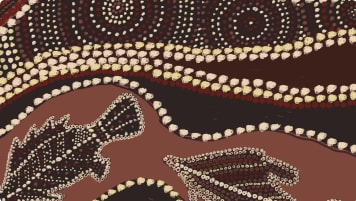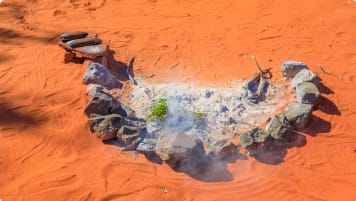Aboriginal Art
Senior and mature couples and solo travellers remain curious but often informed about the role Aboriginal art plays in the indigenous community and the various styles. This article seeks to provide a platform for this collection of small group tours of upto 15 people into the Australian outback where often Aboriginal art styles are encountered.
6 Nov 20 · 15 mins read

Aboriginal Art for small group tours
By Marco Stojanovik
Australian Aboriginal art is the oldest unbroken tradition of art in the world dating back at least 85,000 years. Prior to the arrival of Europeans in Australia, Indigenous people used many art forms including rock engravings, bark painting, body painting, sculpture, weaving and string art. A core concept amongst these, and amongst much contemporary art still, is the spiritual foundation of Aboriginal cultures known as “the Dreaming”. Artworks reflect the many specific Dreaming belief systems unique to particular countries and are therefore incredibly diverse stylistically, filled with various types of symbolism to convey important cultural information.
Several Aboriginal art movements have developed in modern times. These include the Western influenced watercolour landscapes of the Hermannsburg School, made popular by artist Albert Namatjira; the dot paintings of the Papunya and other Western and Central Desert communities, which have led a Renaissance of traditionally influenced contemporary styles; the Wandjina figure paintings and contemporary styles of the Kimberley; the traditional forms of bark, carving, and weaving from Arnhem Land; and the incredibly diverse range of styles and mediums found in urban-based art. The success of these modern movements has worked to maintain connections with Aboriginal traditions and knowledge, ultimately preserving and strengthening culture in the process.
This article explores the history and styles of traditional Aboriginal art and modern movements. The information used is gathered largely from Susan McCulloch’s 1999 book Contemporary Aboriginal Art: A guide to the rebirth of an ancient culture. Additional sources of information include the Japingka Aboriginal Art and Artlandish Aboriginal Art Gallery websites.

Traditional Aboriginal Paintings
For thousands of years prior to colonisation paintings were traditionally drawn by Aboriginals on natural “galleries” such as rock walls or trees, ceremonial articles, as body paint and in dirt or sand.
The earliest forms of permanent Aboriginal artistic works are believed to date back 50,000 years found mainly, although not exclusively, in the many caves, crevices, and walls of rocky escarpments of Arnhem land. Meanwhile ochre paintings on cave walls near Laura on the northern tip of Queensland, as well as images of rain spirit figures in the far north west of Australia, date back 30,000 years.
Ancient rock sites can further be found in South Australia’s Flinders Ranges, around Broken Hill–Lake Mungo-Mootwingee in NSW and along the Murray river, in Victoria’s Grampians, in the southern and northern tablelands of NSW, around Sydney, in the Blue Mountains and the Shoalhaven area of NSW, and in many parts of Tasmania.
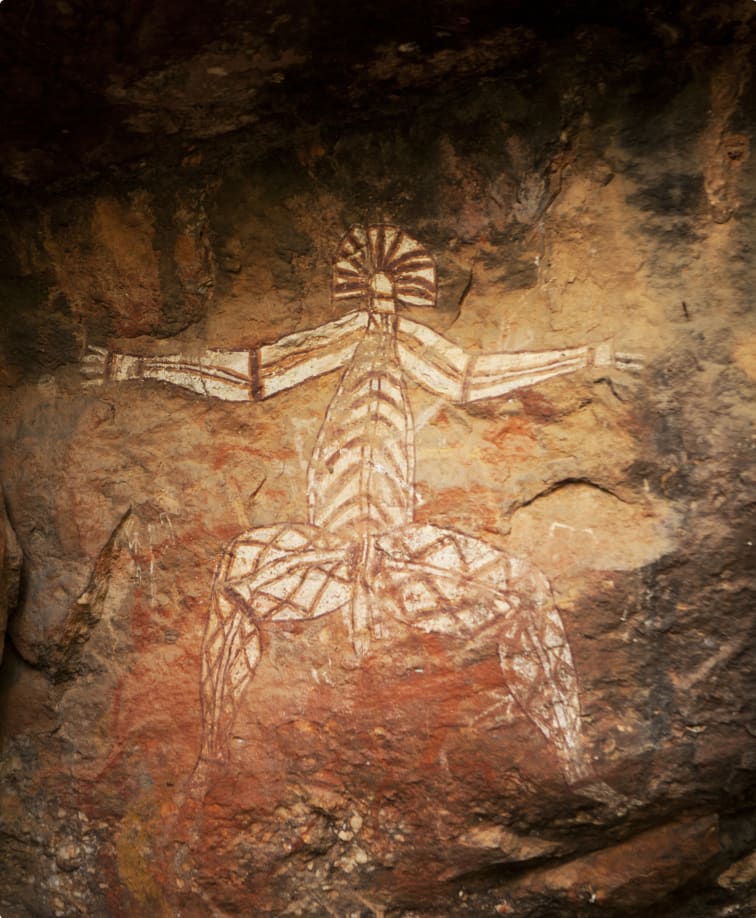
Sacred designs, outlined with circles and encircled with dots, were also painted on the human body or assembled on the ground in dirt or sand. These designs held meanings connected to sacred rituals and were used as part of ceremony together with songs, stories, and dance, not intended to be permanent.
In all, use of painting, drawing, and ceremonial design acted as forms of visual communication, one of two traditional forms of communication used by Australian Aboriginal people along with oral communication (storytelling and songs). With no written language, these forms of communication were used to pass down information necessary for survival such as food and water sources at different times of the year, as well as Dreamtime stories, and obligations to country.

The Dreaming
A central core concept to all Aboriginal art, despite the many different Aboriginal languages and artistic and cultural traditions, is “the Dreaming”. Although not a completely adequate translation and hard to define in terms of non-Aboriginal cultures, the Dreaming broadly refers to the spiritual ideas or foundational beliefs in Aboriginal cultures. Encompassing religious practices, creation mythology, social mores, customs, and laws, the Dreaming provides the identity for Aboriginal people and their association or link to the land.
Many Aboriginal Australians also refer to the world-creation time as “Dreamtime”. Creation is believed to be the work of ancestral heroes who journeyed across a formless land creating all natural phenomena. This spirit of Creation is embodied in the landscape and connected to the people, tying family groups to their own specific Country and sacred sites. Aboriginal mythology is therefore not one simple belief system but many belief systems specific to the hundreds of different tribal groupings occurring throughout the continent
Unlike Western notions of time delineated history, the spirit of the Dreaming is not conceived of being located in the historical past but as an internal process. Traditionally it has been maintained – kept alive at all times – in a ceremonial context encompassing art, song, dance, and storytelling that relate to highly specific physical and cultural landscapes.
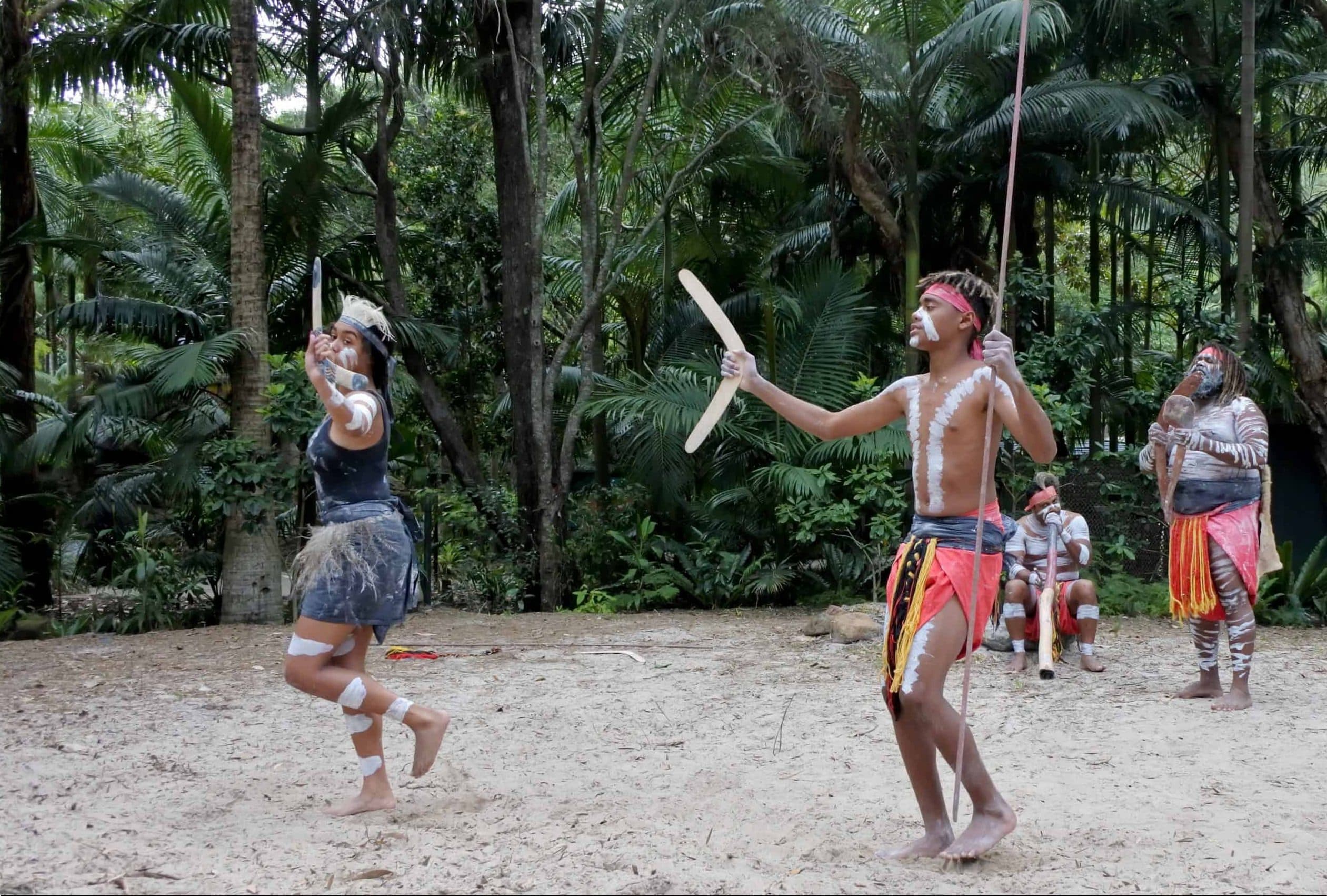
Diversity of Style
Aboriginal artworks each reflect a unique Dreaming inheritance and identity. Representations of the artist’s particular traditional Country is loaded with specific information and knowledge in symbolic form of the land, events, and specific beliefs. As such, Aboriginal artists need permission to paint particular stories, inheriting the rights to them as they are passed down through generations within certain skin groups, and prohibited from painting the Dreaming of another group.
Contemporary styles are therefore incredibly diverse, reflecting the many Dreaming belief systems and unique spiritual links to Country depending on which region the artist is from. Some involve meticulous layering and overlaying, creating works of shimmering luminosity; others have an appealing fresh quality with bold use of colour and raw, free design; yet others portray traditional design in fine detail using age old techniques.
Ultimately, all styles combine a strong sense of design and finely honed sense of colour or surface texture and special relationship – and are underpinned by an intangible but ever present connection with the land, its creators, their stories and the artists’ interaction with this.

Most contemporary styles can be recognised from the communities where they were created. For example, dot painting is identifiable to the Central and Western desert, cross-hatching design and x-ray paintings come from the Northern territory, in particular Arnhem land, and the Wandjina spirit beings come from the Northern territory, in particular Kulumburu.
Choice of colour too continues to reflect the communities’ styles. Papunya Tula, part of the western desert art movement, is known for its use of soft earth colours, whilst many other Western Desert Communities opt for strong primary colours for example. However, overall styles can also vary dramatically even within regions with variations tending to pinpoint more closely to specific communities.
One popular style used by Aboriginal artists is painting from an aerial perspective showing the terrain as a map. In doing so they pass on important knowledge and understanding of their Country, representing important landmarks such as water sources, locations of bush tucker, and sacred sites. Songlines or Dreaming tracks laid down in the Creation time by the spirit Ancestors are also laid down by the artist.
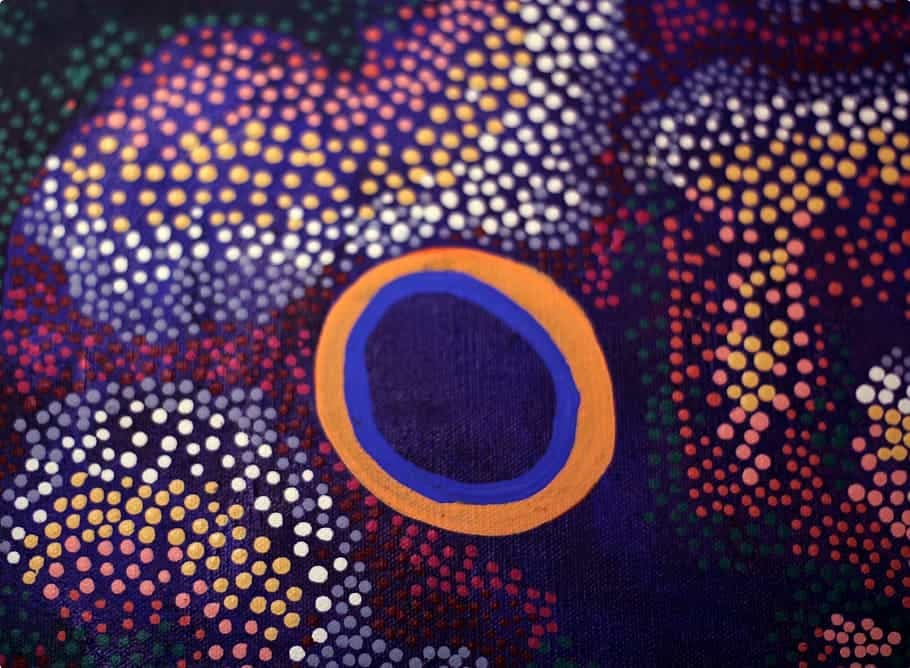
Symbolism
The use of symbols is an integral part of Aboriginal artworks drawing from a continuous tradition going back to rock art and sand paintings. With no written language for Australian Aboriginal People, symbolism is used as an alternate method of conveying important information to preserve culture. Through them cultural stories as well as knowledge of matters of survival and land management are passed down through the generations.
Symbols may thus be used for example to represent features of the land such as hills, waterholes, and hills, or important sites such as campsites and resting places. Some similarities in the imagery include circles, tracks, and parallel bars of straight and wavy lines throughout.
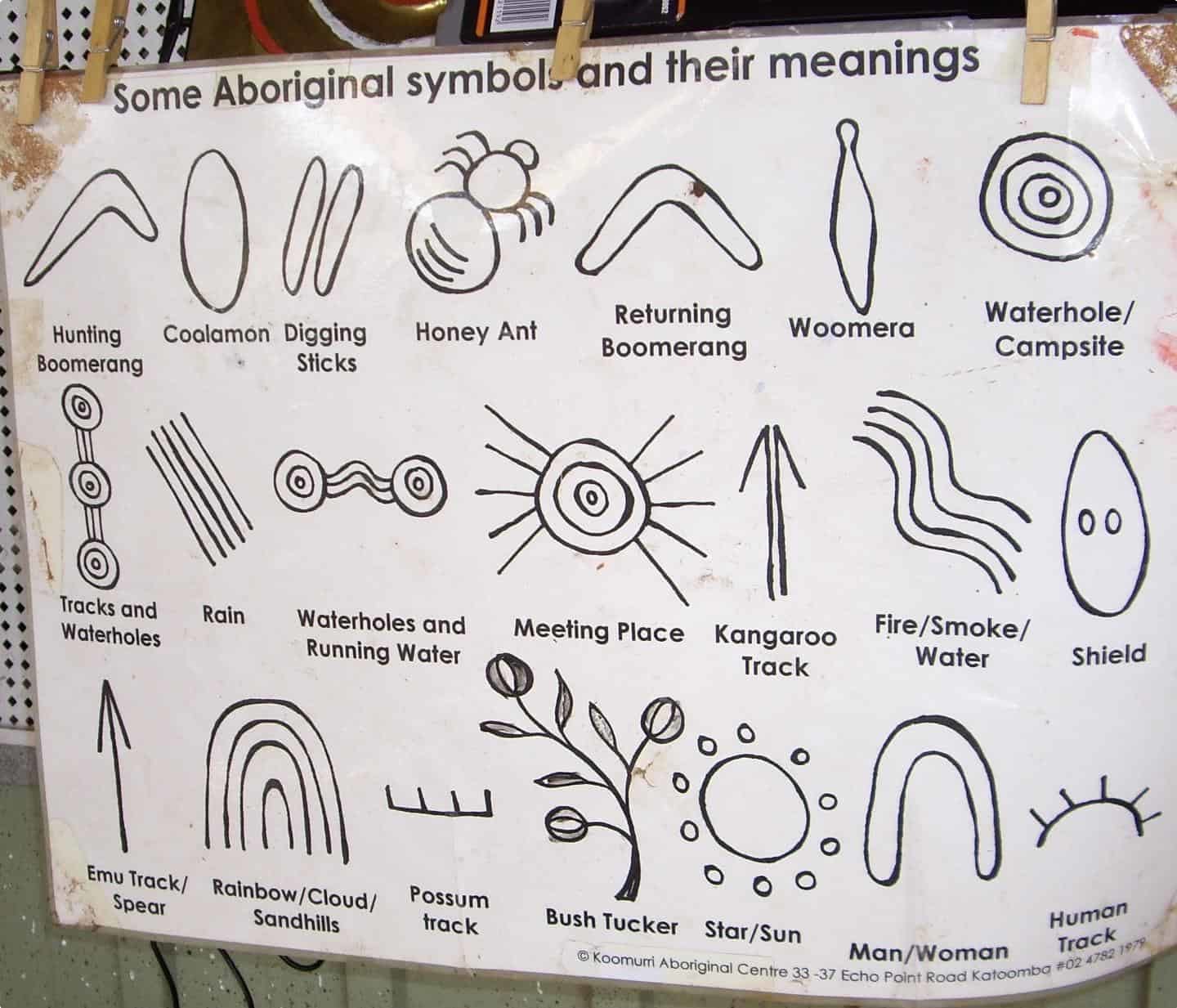
However, it is not always easy for the viewer to interpret these symbols. Groups and individuals use various symbols differently according to context and different traditions and thus their meaning varies widely. There is no guarantee that a certain symbol produces a certain fixed meaning every time.
Additionally, the symbols are often abstracted to disguise the real meanings so as not to be understood by Westerners. This is because designs are not only sacred but also secret. Traditionally they are to be shared solely by the initiated or by specific people of a certain gender or age or located in a particular moiety or subsection of the kinship system.
Albert Namatjira and the Hermannsburg School
Although Aboriginal Australians had been painting with ochres on bodies, bark, and rocks for thousands of years, it was not until the 1930’s that the first paintings on canvas were done. These paintings however were not done with ochre or in traditional styles but drew from an especially Western art style.
In 1934 Australian painter Rex Batterbee introduced the water colour medium to now famous Aboriginal artist Albert Namatjira and other Aboriginal artists at the Hermannsburg mission south of Alice Springs. They would in turn produce beautiful illustrations that distinctively capture the essence of the desert landscape in a way Western artists could never do.
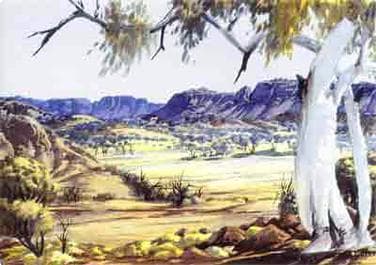
First established in 1938, their paintings sold out at in an instance at exhibitions in Melbourne, Adelaide and other Australian cities, and came to be known as the Hermannsburg School. The school of art continues to this day with artists at Many Hands Art Centre still producing beautiful watercolours of the country around Alice Springs including its waterholes, canyons, and ghost gums.
Namatjira’s clarity in his work as well as his influence as a role model has also had a major impact on subsequent generations of Aboriginal artists of quite different styles. These include the Melbourne based artist Lin Onus, the Central Desert painter Clifford Possum Tjapaltjarri and Northern Territory artist Ginger Riley.

Papunya Desert Art: The Origins of Contemporary Aboriginal Art
The renaissance of modern Aboriginal art styles began 50 years ago at the tiny Central Desert community of Papunya, 230 km from Alice Springs. Papunya was home to many different groups of desert aboriginal people, including Pintupi, Luritja, Walpiri, Arrernte, and Anmatyerre, who had been moved there in the late 1960s under a government policy of assimilation.
In 1971, a young teacher named Geoffrey Bardon became fascinated by the drawings of tract designs in the sand by Aboriginal children he was working with. He encouraged them to recreate their drawings in classroom in water colour and a mural was then planned on the school walls using the traditional style of sand and ceremonial art.
Several senior men soon became involved after explaining to Bardon that the subject matter was more suitable to adults due to the art style’s spiritual purposes and strict protocols around its use.
Coming together from at least a dozen different language groups, these men created a mural depicting the Honey Ant Dreaming, of which Papunya is the centre, the point where Songlines converge.
The mural proved highly influential leading other men to create smaller paintings of their Ancestral stories on just about any available flat surface such as tin cans, match boxes. car bonnets, and corrugated iron sheets. Colours were restricted to variations of red, yellow, black and white produced from crushed ochres, charcoal and pipe clay. Later acrylics were used on canvases supplied by Bardon allowing for more vivid colourful paintings.
In 1972, the artists formed a collective named tula after a small hill near Papunya, a Honey Ant Dreaming site. A movement, generally regarded as the origin of contemporary Indigenous Australian art, had begun.
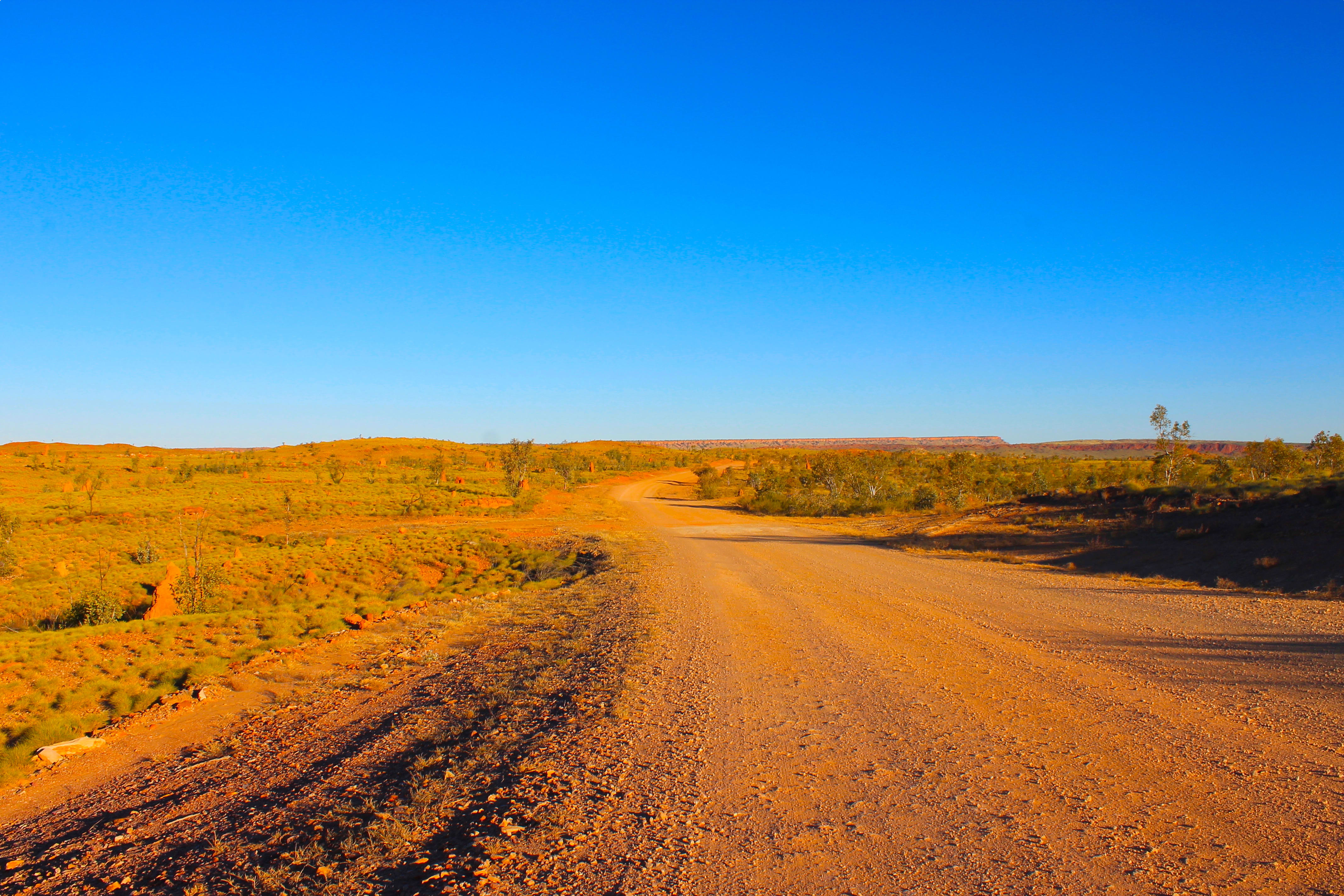
As the movement became more popular, the Aboriginal community became concerned that the artworks were revealing too much of sacred heritage that were being seen by not only Westerners, but Aboriginal people from different regions who were not privy to their tribal stories. And so earlier representations of artefacts, ritual objects and spiritual ceremonies soon disappeared, abstracted into dots to conceal their sacred meanings.
For a number of years, at first, the domestic art market and museums virtually ignored their work. Several early works were instead sent overseas for exhibitions, donated to museums afterwards on proviso they would be on public show. As a result, several overseas galleries have better collections of early art than in Australia. A major exception is the Art Gallery of Northern Territory that has the largest collection of just over 220 early works acquired between 1972-76.
The Art Movement Spreads Through Desert Communities
Gradually from the 1980s people in other communities such as Yuendumu, Balgo Hills, Utopia, as well as numerous other small outstations, settlements, and individuals started making their own paintings, batik, sculpture and craft. The new forms grew to success in the outside world and by the early, 1990s, thousands of Western and Central Desert people had become regular painters or crafts people, working either individual or through their community and cooperative.
These artists from the Western, Gibson and Great Sandy desert regions no longer only use traditional iconography or natural ochres. Paintings today can be colorful, figurative, abstract, bold, and sublime. Art is created by both men and women with a free style that comixes Dreaming narratives of the Ancestors with depictions of historical and contemporary events.
Developments in the Kimberly
The Kimberley region of Western Australia is renowned for the Wandjina figures painted on rock walls, a tradition dating back thousands of years, the oldest continuous sacred painting movement on earth. Unique to the Mowanjum people, the Wandjinas are depicted with large eyes but no mouth, and elaborate headdresses. To these people, the Wandjina Ancestors are the supreme creators of the landscape and its inhabitants and continue to govern potent forces like the weather as well as human behaviour.
When the spirits found the place they would die, it is said they painted their images on cave walls and entered a nearby waterhole. These paintings were then refreshed by Aborigines as a method of regenerating life force.
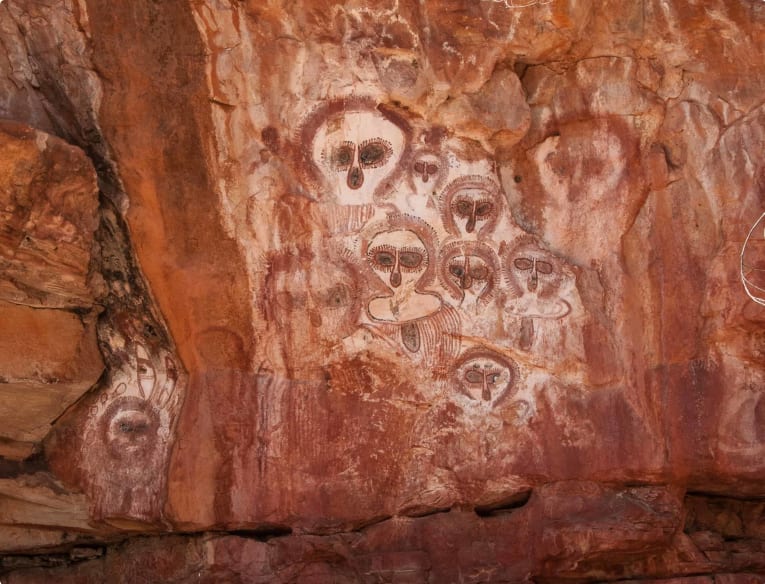
In the late 1960s and early ‘70s several Mowanjum artists depicted traditional Wandjina on pieces of string bark. These artworks were sold mainly through the mission at Kulumbaru and are now in major museum collections around the world. Some of the important artists from this region include Alex Mingelmanganu, Charlie Numbelmoore and Jack Karedada.
There are also several distinct styles of modern Kimberley art. The first forms emerged in the late 1970s on boards produced by Warmum (Turkey Creek) people in the East Kimberley. These ochre paintings were completely different from the dot style developed in the Central Desert area, instead characterized by expanses or blocks of single colour interspersed by white dotted lines. The picture plane is divided up into differing tonal areas imbuing the paintings with an aerial perspective.
In the mid-1980s the Western-Desert Kimberley region of Balgo Hills, who have strong connections with the Central Desert community of Papunya, started painting in acrylic on canvas. And at the same time, a number of Fitzroy Crossing residents started painting in brightly coloured watercolour. These artists from both regions use interlocking geometric patterns in their paintings that traditionally adorn ritual and decorative objects such as shells, shields, and spear-throwers.
From the early 1980s, a new art tradition emerged led by Paddy Jaminji and Rover Thomas who introduced bold textured and ochred landscape paintings of Country and of significant historic events.

Arnhem Land
The art in Arnhem Land in the Northern Territory is quite separate and distinct from the desert art of Central Australia. In the coastal regions of Australia’s Top End, image making had been produced for sale or barter for several hundred years. Painted barks, carvings and other transportable objects were traded the Makassans during the 1700s, white anthropologists from the 1800s, and tourists from the 1900s.
Great interest in Arnhem art emerged in the late 1950s and ‘60s after Tony Tuckson, director of the Art Gallery of NSW, accepted a gift from anthropologist Dr Stuart Scougall of a specially made set of Melville Island Tiwi burial poles known as Tutini. The 17 poles were placed in the gallery’s foyer, drawing both criticism for their placement in such a prominent position as well as inspiring a number of leading modern artists such as Sir Russel Dyrsdale, Sali Herman and Margaret Preston.

A year earlier, some major bark painters from Yirrkala on the Northeastern tip of Arnhem Land also produced the Yirrkala Bark Petition. This was the first formal assertion of Indigenous native title, and the first example of an art work making a powerful political and cultural statement.
At the same time, Yirrkala elders, fearing a complete loss of their culture, also instigated a unique community project to create encyclopaedic bark paintings on un unprecedented scale. Known as the ‘Church Panels’, they today remain in the collection of the community’s Baku Larrngay Mulka Arts Centre and are still considered one of the most important Australian artworks.
During the 1970s and ‘80s Arnhem Land missions and settlements such as Yirrkala, Maningrida, Ramingining, Oenpelli (Gunbalanya) and Echo islands were returned to Aboriginal control. Community art centres have been established in all of these, taking the traditional forms of bark, carving, and weaving into the realm of contemporary art.

Urban Art
Since the late 1980s, appreciation of Aboriginal art has broadened through the development of a strong school of urban-based art. The term ‘urban’ art refers mainly to artists working in major capital cities and within the general Australian contemporary arts scene rather than those working in Aboriginal communities from a more ‘traditional’ framework.
These artworks add a further dimension to the work of land-based artists, commenting clearly on recent Aboriginal history and dealing with social, cultural, and political issues such as the stolen generations, land rights, and reconciliation.
Artists are both self-taught and professionally trained, and use multiple forms of media. Artworks range from photography and video art, to graffiti paintings, mixed media, paintings that mix traditional and modern techniques, and more. Some of the well known artists include Tracey Moffatt, Lin Onus, Michael Riley, Trevor Nickolls, Christopher Pease, Fiona Foley and numerous others.
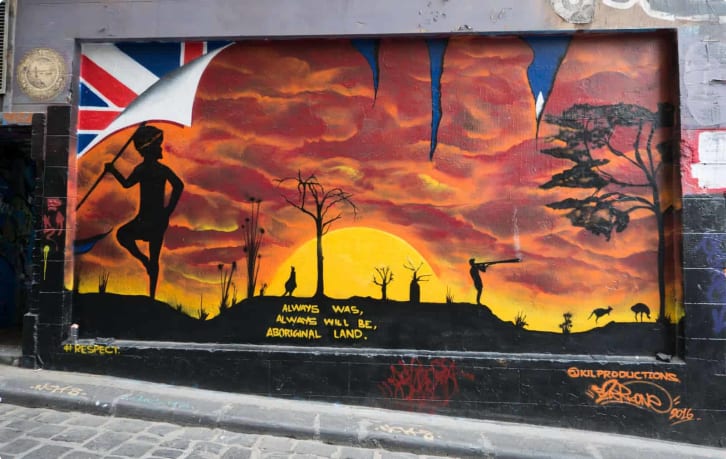
Conclusion: A Strengthening of Aboriginal Culture
Today Aboriginal art continues to be produced in hundreds of remote communities around Australia and by urban Aboriginal artists. This contemporary art movement continues to act as a powerful bridge between both Aboriginal and western cultures and between the ancient and the contemporary. In doing so it has fuelled a great interest in preserving and strengthening culture in Aboriginal society by recognising and reinforcing the values of traditional knowledge, which forms the basis of Aboriginal art.
Indigenous owned art centres particularly play a vital role in maintaining the flourishing art movement and associated reconnection with culture. The more than 250 Indigenous art centres in remote communities around Australia providing an important focus and centre for the communities. Elders, artists and young people can all come together, talk about stories and culture and then paint those stories.
Most art centres operate online art galleries where local and international visitors can purchase works directly, as well as working in a partnership with leading galleries in Australia and worldwide to promote their art and culture to as wide an audience as possible. With this, their art has increasingly become a significant source of income, livelihood, and sense of pride for many of these communities. Supporting Aboriginal art thus in turn has an indirect effect of supporting the language and culture of Indigenous families who are able to remain living in remote locations linked to their own ancestral lands.
Tour of Aboriginal Art & Culture
Odyssey Traveller provides the opportunity to view Aboriginal art on several of our Australian tours:
- We visit Aboriginal art galleries and learn about the contemporary Aboriginal art movement in Alice Springs on our tour of Alice Springs and Uluru-Kata Tjuta National Park. Alice Springs, or simply ‘Alice’ as it is known now colloquially, is famous for the ochre sands and mountain ranges that surround it, its many Aboriginal art galleries, and cultural events. The Arrernte people, who have lived in the Central Australian Desert in an around what is today Alice Springs for thousands of years, still today sustain a strong connection to this land and a rich culture.
- We visit significant sites of Indigenous rock art on our Tour of the Kimberley. This fascinating region of Western Australia – over 400, 000 square kilometres of pristine wilderness spanning Australia’s north west from Broome to Darwin – is home to thousands of ancient rock art sites, believed to be the world’s oldest examples of the art. Set amongst the stunning scenery of the Kimberley – river gorges, boab trees, sandstone formations, waterfalls and pristine beaches – these extraordinary paintings are a testament to an ancient civilisation that remains vital today.
- We also learn about the Aboriginal culture and art of Kakadu as part of our new tour of Kakadu and the Northern Territory. The ‘Stone Country’ of Kakadu National Park boasts over 5,000 known Aboriginal rock art sites, with some archaeologists believing that there might be up to 15,000 total sites across the entire park – the greatest known concentration of rock art in the world. Some of the rock paintings are up to 20, 000 years old, constituting one of the longest historical records of any group of people in the world.
Travellers with an interest in learning more about the Aboriginal heritage of Australia may also want to check out our other outback Australia tours, which include visits to Lake Mungo and the Budj Bim Cultural Landscape as part of our new tour of the Southern States of Australia; to the important cultural site of Wilpena Pound on our tour of the Flinders Ranges; and to the Brewarrina Fish Traps in outback Queensland.
Odyssey Traveller has been serving world travellers since 1983. All tours provide an authentic and culturally informed travel experience, that goes beyond the usual tourist sites in favour of drawing out the hidden histories of our destinations. Our guides are chosen for their local expertise, and we move in genuinely small groups: usually 6-12 per tour. Our tours are all-inclusive, encompassing accommodation, attraction entries, and transport. For more information, click here, and head to this page to make a booking.
Articles about Australia published by Odyssey Traveller:
- The Australian Outback: A Definitive Guide
- Uncovering the Ancient History of Aboriginal Australia
- Aboriginal History and Culture of Kakadu National Park
- Aboriginal Land Use in the Mallee
- Understanding Aboriginal Aquaculture
- Aboriginal Art
- Appreciating Australian River Systems
- Charles Sturt and the Search for the Inland Sea
- Camels of the Australian outback
- The Kimberley: A Definitive Guide
For all the articles Odyssey Traveller has published for mature aged and senior travellers, click through on this link.
External articles to assist your visit to Australia:
- The Essential Introduction to Aboriginal Art (25 Facts)
- The Story of Aboriginal Art
- 10 Indigenous Artists You Should Know
- Contemporary Aboriginal Art from the Dreaming
- The Definitive Guide to Modern Aboriginal Art
We acknowledge Aboriginal and Torres Strait Islander peoples as the First Australians and Traditional Custodians of the lands where we live, learn and work. We pay our respects to Elders past, present and emerging.
Australian tours of the outback

14 days
Mar, May, Jun, Jul, Aug +3Escorted small group tour of Western New South Wales
Visiting New South Wales
Discover the the Brewarrina fish traps, Aboriginal art at Mt Grenfell and visit the opal fields of White Cliffs. This small group also visits the World Heritage Site of Mungo man and lady stopping in Mungo National Park and other significant locations such as Broken Hill.
From A$9,250 AUD
View Tour
days
Mar, May, Aug, Sep, Oct +2Small group tour of World Heritage sites and more in the Southern States of Australia
Visiting New South Wales, South Australia
Discover the World Heritage Sites of the southern states of Australia travelling in a small group tour. A journey of learning around the southern edges of the Murray Darling basin and up to the upper southern part of this complex river basin north of Mildura. We start and end in Adelaide, stopping in Broken Hill, Mungo National Park and other significant locations.
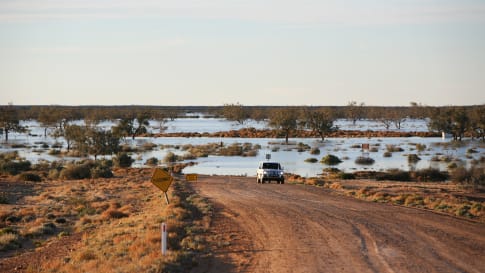
65 days
MarLong tour of Australia for a small group
Visiting New South Wales, Northern Territory
Small group tour for senior couples and solo travellers touring Australia. Travelling through the outback and visiting many of the famous sights as well as off the beaten track locations. Learn about the history of the people who explored the deserts, from indigenous communities to Europeans, as well as Burke and Wills, visit White Cliffs, Marree and far north Kakadu and the Kimberley.
From A$48,995 AUD
View Tour
13 days
May, Jun, Jul, Aug, SepSmall group tour of Australia's Kimberley
Visiting Western Australia
Escorted small group tour of the Kimberley. We explore and visit The Bungles, Bell Gorge, Mitchell plateau & Halls Creek in the dry season. Amazing landscapes intertwined with Aboriginal communities resident more than 45,000 years.
From A$15,390 AUD
View Tour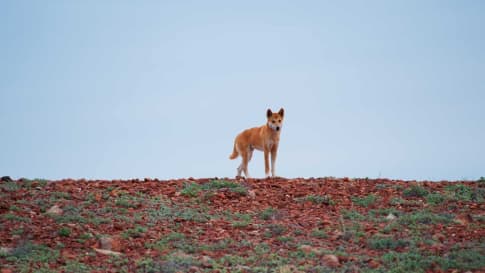
days
Apr, May, Jul, Aug, Oct +2Small group tour of Australia's Flinders ranges
Visiting South Australia
Escorted small group tour of the Flinders range in South Australia from Adelaide. Learn about Coober Pedy, Wilpena pound and water system of Lake Eyre as we explore and learn also about the history of the people who explored the Flinders.
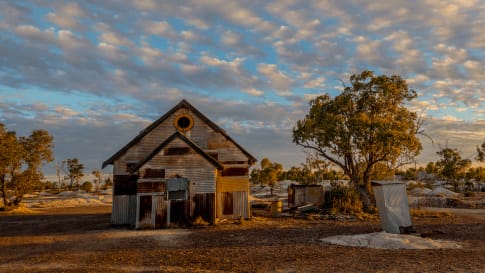
days
Mar, Apr, May, Jul, Aug +2Small group tour of outback Queensland
Visiting New South Wales, Queensland
To Dubbo and back, this small group tour takes you to learn about the Brewarrina fish traps, we travel high up into North Queensland to see the Dinosaurs of Winton and incredible Aboriginal rock art at Cathedral gorge and learn about opal mining and the history of Lightning ridge.
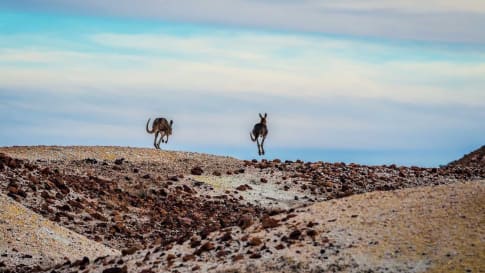
13 days
Mar, OctSmall group tour; Broken Hill and back
Visiting New South Wales, Queensland
Small group tour of New South Wales, Queensland & South Australia deserts, from Broken Hill. Learn about the history of the people who explored the deserts, from indigenous communities to Europeans, as well as Burke and Wills, visit White Cliffs, Birdsville, Maree.
From A$11,550 AUD
View Tour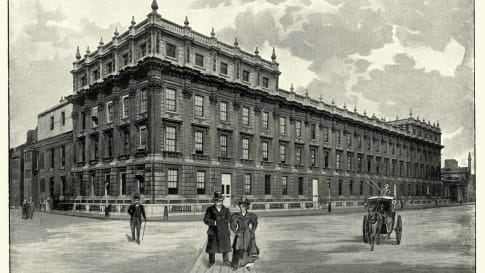
days
JanVictorian Britain | Summer School course
Visiting Tasmania
This course will look at the life and times of Queen Victoria who reigned over the British Empire between 1837 and 1901. During that period Britain underwent what amounted to a revolution in industry, agriculture, transport, politics, science, medicine and the arts.
Articles

Aboriginal culture of the Flinders Ranges, South Australia
The iconic Flinders Ranges of South Australia have a rich Aboriginal heritage and are home to a number of vitally important cultural sites and ancient artworks that this small group tour for mature and senior travellers has the opportunity its to learn about.

Aboriginal history and culture of Kakadu National Park, Northern Territory
For those seek to learn as they travel then the history of the Aboriginal journey and timelines that unfold as a discovery in Australia seek to fascinate the mature and senior traveller on a small group package tour for couples and singles. From Darwin, this tour also visits Arnhem land as well as Kakadu, during the dry season.

Aboriginal land use in the Mallee
Learning about the Mallee for a escorted small group tour of South Australia and Western Australia for mature and senior travellers. Understand the Mallee & Wildflowers relationship and the indigenous community land use.

Aboriginal Rock Art in the Kimberley, Australia
The Kimberley is explored on a small group tour for mature and senior travelers, couples or singles. Both Aboriginal community is studied and an appreciation of the wet and dry seasons. This guide on the Kimberley assists the traveler as you start from Broome and travel round via Halls creek and Purnunulu national park over some 17 days in a group of up to 12 people.

Aboriginal Sites of Importance in Outback Queensland, Australia
Outback Queensland is hiding a number of unforgettable indigenous experiences on this small group tour for senior travellers. Especially at the Brewarrina Fish Traps, and Carnarvon Gorge, for example where you can experience and learn about dreamtime creation stories, age-old cultural practices and traditions, and Aboriginal art.

Ancient Aboriginal trade routes of Australia
Ancient Aboriginal trade routes of Australia Trade was a central part of life for Aboriginal people prior to the British settlement of Australia. Trading routes criss-crossed the nation, dispersing goods, information, technologies and culture thousands…

Landscape of Southern Australia from Mallee and Mulga.
Escorted small group tours for mature and senior travellers in Western Australia, Victoria, South Australia & NSW drive through former Mallee country. Article explains the iconic beginnings of Mallee and Mulga in the arid landscapes.

Madjedbebe Archaeological Site, Northern Territory
Madjedbebe Archaeological Site, Northern Territory Near the border of western Arnhem Land and Kakadu National Park in Australia’s ‘top end’, Madjedbebe rock shelter (formerly known as Malakunanja II) is the oldest archaeological site in Australia,…
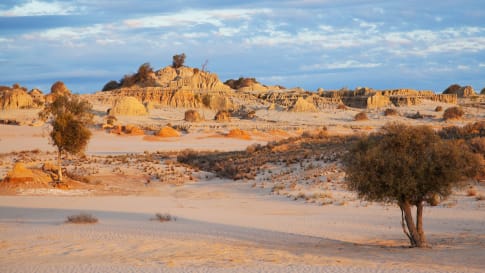
Mungo Man and Mungo Lady, New South Wales
Part of a small group tour of World heritage sites on Victoria, NSW & South Australia for mature and senior travellers. Learn and explore in the Mungo National park about Aboriginal settlement and the fauna and flora of this National park.

The Australian Outback: A Definitive Guide
Explore learn and consider what is the outback in this article. For mature and senior travelers considering joining a small group package tours into the outback to see, learn and explore about this unique place, not only the landscape but the Aboriginal approach to living. On each of the tours for couples and the single traveler you learn something different but fascinating, from Outback Queensland, the Flinders, Broken Hill and the Kimberley and the wildflowers all contribute to this question, what is the outback?

Uncovering the ancient history of Aboriginal Australia
For small group escorted tours of Australia in Queensland, Victoria, New South Wales, South Australia, Tasmania, Western Australia and the Northern Territory a guide on Aboriginal culture for mature and senior travellers.
